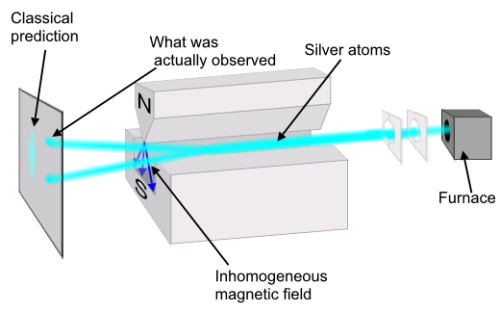#relative frequency
The Stern-Gerlach Experiment
In 1922 at the University of Frankfurt in Frankfurt, Germany, Otto SternandWalther Gerlach sent a beam of silver atoms through an inhomogeneous magnetic field in their experimental device. They were taking a look at the new concept of quantized spin angular momentum. If indeed the spin associated with particles could only take on two or some other countable number of states, then the atoms transmitted through the other end of their machine should come out as two (or more) concentrated beams. Meanwhile if the quantum theory was wrong, classical physics predicted that the profile of a single smeared-out beam would result on the detector screen, due to the magnetic field deflecting each randomly spin-oriented atom a different amount on a continuous, rather than discrete, scale.
As you can see above, the results of the Stern-Gerlach experiment confirmed the quantization of spin for elementary particles.
Spin and quantum states
A spin-½ particle actually corresponds to a qubit
|ψ> = c1|ψ↑> + c2|ψ↓>
a wavefunction representing a particle whose quantum state can be seen as the superposition (or linear combination) of two pure states, one for each kind of possible spin along a chosen axis (such as x, y or z). The silver atoms of Stern and Gerlach’s experiment fit in this description because they are made of spin-½ particles (electrons and quarks, which make up protons and neutrons).
Significantly, the constant coefficients c1 and c2 are complex and can’t be directly measured. But the squared moduli ||c1||2 and ||c2||2 of these coefficients represent the probability that a particle in state |ψ> will be observed as spin up or down at the detector.
||c1||2 + ||c2||2 = 1 : it is certain that the particle will be detected in one of the two spin states.
That means when we pass a large sample of particles in identical quantum states through a Stern-Gerlach (S-G) machine and detector, we are actually measuring the probabilities that the particle will adopt the spin up or spin down states along the particular axis of the S-G machine. This follows the relative-frequency interpretation of probability, where as the number of identical trials grows large the relative frequency of an event approaches the true probability that the event will occur in any one trial.
By moving the screen so that either the up or down beam is allowed to pass while the the other is stopped at the screen, we are “polarizing” the beam to a certain spin orientation along the S-G machine axis. We can then place one or more S-G machines with stops in front of that beam and reproduce all the experiments analogous to linear polarization of light.
Post link

